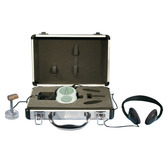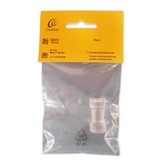Baha & Ponto Listener
For daily testing of a BAHA by a carer/parent/teacher
Like any conventional hearing aid, a BAHA needs regular daily testing to ensure that it is working correctly. Until now, it was difficult for a carer to check the Baha/Ponto but these listeners makes it an easy daily task.
The Baha/Ponto listener is suitable for use with both Cochlear and Oticon Ponto bone anchored hearing aids. The kit includes a special Baha/Ponto mount which is linked to an amplifier which in turn allows the Baha/Ponto to be listened to via the headphones supplied. It is supplied in a neat silver mini flight cases and are extremely easy and convenient to use. The amplifier does not even have to be removed from the case and the mount and headphones can be kept connected and ready for use.
Hearing aid users, who want to be able to check a Baha/Ponto, can use the Baha/Ponto listener by purchasing a set of blue plugged personal stereo V leads (such as DPV1M5) or an inductive neck loop. The output of the Baha/Ponto will then be fed directly into their own hearing aids.
Connevans would like to acknowledge the help and motivation of the Ewing Foundation for the original development of the Baha Listener.
-
BAHA 22 listener for Baha & Ponto
£231.79 (£193.16 ex VAT)37BAHALIS22
Standard model - Baha/Ponto 22 listener for use with both Cochlear and Oticon bone anchored hearing aids
-
Cochlear Baha test rod
£18.82 (£15.68 ex VAT)DCBA92612
Cochlear Baha test rod (also known as a bitebar)
Bone Anchored Hearing Aids
A BAHA System combines a sound processor with a small titanium fixture implanted behind the ear. The system allows sound to be conducted through the bone rather than via the middle ear a process known as direct bone conduction. Surgery is minor, and many patients report a wide range of advantages over other hearing devices.
How does BAHA work?
A small titanium fixture is implanted in the bone behind the ear where it osseointegrates or bonds to the living bone. After a healing period a percutaneous (through the skin) abutment is attached to the fixture. The sound processor can then be connected and disconnected at will. The BAHA sound processor transmits sound directly via the titanium fixture to the inner ear.
The BAHA sound processor simply snaps into the abutment which is attached to the fixture in the bone. Sound is transmitted directly via the bone to the inner ear.
Connevans would like to acknowledge the help and motivation of the Ewing Foundation for the introduction of the Baha Listener.






